Maple Grove Methodist Church
Friday, September 19th, 2008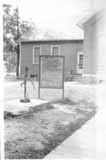 The old brick school house which became the foundational building of Maple Grove Church was originally built in 1878. The church was organized around 1919, and began meeting in the abandoned school around 1920. In 1923 a frame addition was dedicated and this served as their parish hall for many years. In 1929 the lot was further expanded, and a campaign for new construction began shortly thereafter. (Photo courtesy of the Maple Grove Methodist Church)
The old brick school house which became the foundational building of Maple Grove Church was originally built in 1878. The church was organized around 1919, and began meeting in the abandoned school around 1920. In 1923 a frame addition was dedicated and this served as their parish hall for many years. In 1929 the lot was further expanded, and a campaign for new construction began shortly thereafter. (Photo courtesy of the Maple Grove Methodist Church)
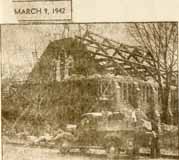 The cornerstone was laid on Pearl Harbor Day in 1941. A stop light was installed at the corner of Henderson and High in 1940—a real sign of growth and “progress.”
The cornerstone was laid on Pearl Harbor Day in 1941. A stop light was installed at the corner of Henderson and High in 1940—a real sign of growth and “progress.”
(Photo courtesy of the Maple Grove Methodist Church)
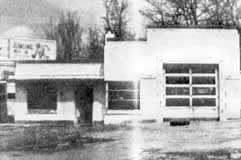 Because of gas rationing during World War II, many gas stations closed. In 1942, Clintonville Community Council (an umbrella group of Clintonville’s organizations) transformed this vacant gas station at
Because of gas rationing during World War II, many gas stations closed. In 1942, Clintonville Community Council (an umbrella group of Clintonville’s organizations) transformed this vacant gas station at 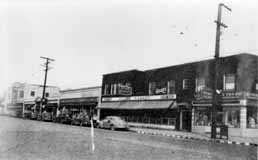 This is another view of downtown Clintonville at High Street and Oakland Park Avenue, showing Miller’s Market, Alber’s supermarket, and Oakland Park Pharmacy. The pharmacy had a soda fountain and was undoubtedly a favorite ice cream stop during hot summer evenings. (Photo courtesy of Leeann Faust)
This is another view of downtown Clintonville at High Street and Oakland Park Avenue, showing Miller’s Market, Alber’s supermarket, and Oakland Park Pharmacy. The pharmacy had a soda fountain and was undoubtedly a favorite ice cream stop during hot summer evenings. (Photo courtesy of Leeann Faust) World War II affected every man, woman and child in the community. This World War II signboard listing those who served in the war stood on High Street between Dunedin and Piedmont and honored WWII serviceman from Clintonville. (Photo courtesy of Gordon Brevoort)
World War II affected every man, woman and child in the community. This World War II signboard listing those who served in the war stood on High Street between Dunedin and Piedmont and honored WWII serviceman from Clintonville. (Photo courtesy of Gordon Brevoort)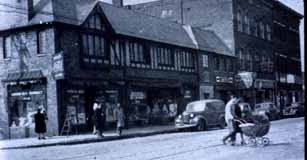 This is a view of North High Street looking northwest from Hudson Street during the mid-1940s. The picture shows Hudson-High Pharmacy, Kroger, Minnie Metzgers Grill, and Neoacacia Hall (a Masonic lodge). The tallest building, the Ramlow Building, was built in the late 1800s by Catherine (Seeger) Volk Ramlow. (Photo courtesy of Columbus Metropolitan Libraries)
This is a view of North High Street looking northwest from Hudson Street during the mid-1940s. The picture shows Hudson-High Pharmacy, Kroger, Minnie Metzgers Grill, and Neoacacia Hall (a Masonic lodge). The tallest building, the Ramlow Building, was built in the late 1800s by Catherine (Seeger) Volk Ramlow. (Photo courtesy of Columbus Metropolitan Libraries) One of Clintonville’s notables was George Sidney Marshall (869-1956). He was raised on a farm in Perry County and attended Ohio State University. He graduated from OSU in 1894 and then from its law school in 1897. He was active in local politics, and became mayor in 1910 on the Republican ticket. After his term of mayor, he returned to the practice of Law and retired in 1946. He and his wife had a longstanding interest in music, and formed the Clintonville Music Study Club. In his retirement (and after the death of his wife), Marshall wrote a history of music in Columbus, a thorough account of all the local nonprofit musical organizations across the city. His book, called
One of Clintonville’s notables was George Sidney Marshall (869-1956). He was raised on a farm in Perry County and attended Ohio State University. He graduated from OSU in 1894 and then from its law school in 1897. He was active in local politics, and became mayor in 1910 on the Republican ticket. After his term of mayor, he returned to the practice of Law and retired in 1946. He and his wife had a longstanding interest in music, and formed the Clintonville Music Study Club. In his retirement (and after the death of his wife), Marshall wrote a history of music in Columbus, a thorough account of all the local nonprofit musical organizations across the city. His book, called 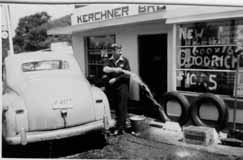 In 1948, the garage on the northeast corner of Glenmont and High that had been used as a World War II Civilian Defense Center was purchased by Joseph Kerchner. His brother George soon joined him. The brothers ran the Sohio Kerchner Brothers garage and filling station from until 1950. (Photo courtesy of the Kerchner family)
In 1948, the garage on the northeast corner of Glenmont and High that had been used as a World War II Civilian Defense Center was purchased by Joseph Kerchner. His brother George soon joined him. The brothers ran the Sohio Kerchner Brothers garage and filling station from until 1950. (Photo courtesy of the Kerchner family)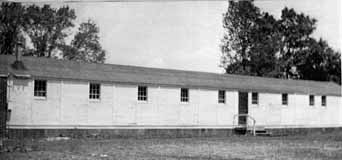
 These children are a little stiff, and obviously no one told them to “say cheese”. But the children are cute and some of my readers may be in this photo. These are Our Lady of Peace students in the late 1940s, taken by photographer Ken Hauer. (Photo courtesy of Marge Hauer)
These children are a little stiff, and obviously no one told them to “say cheese”. But the children are cute and some of my readers may be in this photo. These are Our Lady of Peace students in the late 1940s, taken by photographer Ken Hauer. (Photo courtesy of Marge Hauer)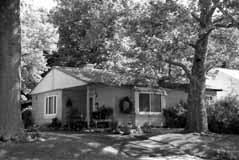 Between 1948 and 1950, the Columbus-based Lustron Company made 2,500 all-steel, prefabricated houses and shipped them nationwide. Unlike the more traditional architecture of Sears homes, Lustron houses offered a sleek, modern aesthetic. They were easy to maintain, and affordable. Despite a backlog of orders, the company went bankrupt in 1950. There are 4 porcelain-steel Lustron homes in Clintonville; this one is located at 272 East Weisheimer. (Photo courtesy of Lynn McNish)
Between 1948 and 1950, the Columbus-based Lustron Company made 2,500 all-steel, prefabricated houses and shipped them nationwide. Unlike the more traditional architecture of Sears homes, Lustron houses offered a sleek, modern aesthetic. They were easy to maintain, and affordable. Despite a backlog of orders, the company went bankrupt in 1950. There are 4 porcelain-steel Lustron homes in Clintonville; this one is located at 272 East Weisheimer. (Photo courtesy of Lynn McNish)